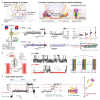Nano-Precision Tweezers for Mechanosensitive Proteins and Beyond
- PMID: 35114644
- PMCID: PMC8819490
- DOI: 10.14348/molcells.2022.2026
Nano-Precision Tweezers for Mechanosensitive Proteins and Beyond
Abstract
Mechanical forces play pivotal roles in regulating cell shape, function, and fate. Key players that govern the mechanobiological interplay are the mechanosensitive proteins found on cell membranes and in cytoskeleton. Their unique nanomechanics can be interrogated using single-molecule tweezers, which can apply controlled forces to the proteins and simultaneously measure the ensuing structural changes. Breakthroughs in high-resolution tweezers have enabled the routine monitoring of nanometer-scale, millisecond dynamics as a function of force. Undoubtedly, the advancement of structural biology will be further fueled by integrating static atomic-resolution structures and their dynamic changes and interactions observed with the force application techniques. In this minireview, we will introduce the general principles of single-molecule tweezers and their recent applications to the studies of force-bearing proteins, including the synaptic proteins that need to be categorized as mechanosensitive in a broad sense. We anticipate that the impact of nano-precision approaches in mechanobiology research will continue to grow in the future.
Keywords: SNARE complex; mechanosensitive proteins; single-molecule tweezers; synapse mechanobiology.
Conflict of interest statement
The authors have no potential conflicts of interest to disclose.
Figures



References
-
- Arya M., Anvari B., Romo G.M., Cruz M.A., Dong J.F., McIntire L.V., Moake J.L., López J.A. Ultralarge multimers of von Willebrand factor form spontaneous high-strength bonds with the platelet glycoprotein Ib-IX complex: studies using optical tweezers. Blood. 2002;99:3971–3977. doi: 10.1182/blood-2001-11-0060. - DOI - PubMed
Publication types
MeSH terms
Substances
LinkOut - more resources
Full Text Sources

